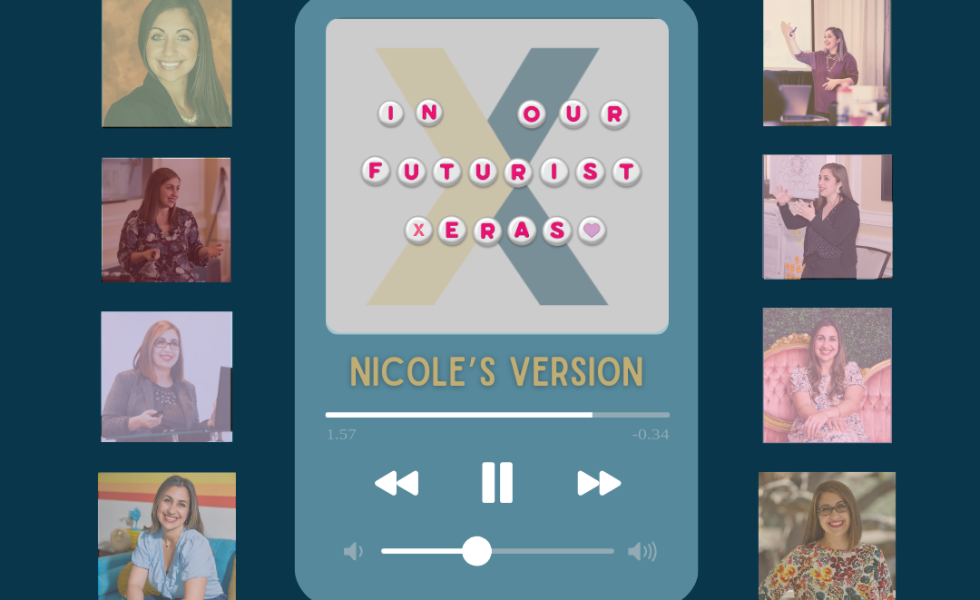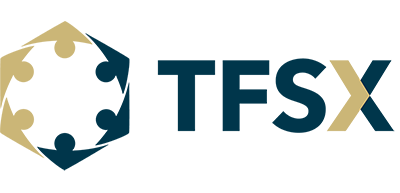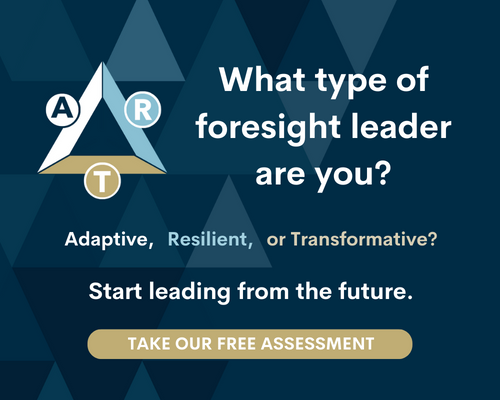My Futurist Era: Nicole’s Version

Chapter One – Dancing on my own, I make the moves up as I go
My foresight journey began on a Marley dance floor. While I studied dance formally throughout my entire young life, I never felt like I really fit the mold of a traditional dancer. I wanted to bend differently, respecting my technique while ultimately telling an immersive story to the audience in a way that felt fluid and organic. Two milestones finally made me feel validated that my way was in fact a way. The first was a discovery of modern dance which empowered me to be raw and flex while others only pointed. I had the honor to learn and perform Alvin Ailey’s infamous Revelations piece, a dance using African-American song and soul to explore deep grief and joy. The second milestone was learning the work of Bob Fosse, known for revolutionizing musicals with unique (even provocative) moves to express introspective and dark plots. You often see a flick of a hat, shoulder shrug, or intricate swirl of the hips to powerful jazz music. In 1999 I went to NYC and saw Fosse, a showcase of his work, feeling overcome with emotion and connection with the dancers on the stage. All of this showed me the possibilities of pushing the boundaries while building empathy for all ways of knowing. I was a world builder who used my unique gifts of movement to tell the stories that often got left behind or others didn’t have the courage to express.
Chapter Two – They’d say I hustled, put in the work
It felt like I hit the jackpot when I discovered that there was an academic field that expanded my passion for storytelling through movement to also include language (non-verbal and verbal). Pursuing a Master’s degree in Interpersonal Communication, drew me to qualitative methods of deep listening and understanding, like ethnography, and how interactions shape reality and self expression. A course on social construction, or how language is used to shape identity / realities, was so influential on me that the theory became the basis of my multi-year (yes, more like a dissertation!) thesis. I interviewed 25 HR leaders in the hospitality industry to understand their perception of the communication “rules” that the Millennial generation employees followed or broke, impacting their organizational assimilation. Through thematic analysis, I identified key themes, which led to published journal articles in the OD, higher ed, and communication sectors. These couple of years were some of the most demanding with the writing load and simply accepting how social construction forced me to question everything I knew (gender, time, etc.). Yet, through it all, I had permission to use my sensemaking brain in its natural form to produce recommendations that others wanted to hear.
In fact, during the thesis development, I expanded my network to include organizational development professionals, learning and development leaders, and beyond. A mutual connection introduced me to Yvette and Frank who were hiring someone who was predispositioned to understand foresight but was not yet formally trained. Check, check! With a quick exploration of the foresight field and then a call with Kedge, it was a no-brainer for me to take this leap. Foresight focused on people, and I had an opportunity to mesh together embodiment, language, and connection for futures to come.
Chapter Three – This was the very first page, not where the story line ends
My first day on the job with Kedge was a flight to Japan to work with the Walt Disney International team. I was thrown right in with an opportunity to learn by doing. During that first trip, I understood that this practice was truly emergent. There was no script, nor should there be, to navigating the professional (and personal) transformations unfolding. I continued with Yvette and Frank during the early stages of the business and actively observed their conversations while adding value through the development of exercises like ethnographic futures. It was invigorating to spend long hours with them working through client needs, implementing ideas, building our first public-facing program, The Futures School, and making a space for myself as a speaker.
In 2016, I took a sabbatical just shy of two years and worked in continuing education for one of the largest universities in the United States. I saw how long-term planning was sparse and how any talk of novel partnerships and programming made most of the staff feel scared and paralyzed. Generally, there was greater comfort in allocating resources to long-standing programs that were actually at risk of extinction, rather than investing in the development of learning experiences that would upskill professionals for the capabilities of the future. It felt difficult to thrive in an environment of risk-aversion, which was much too common within the higher education sector. What I did take away from the experience was a deep understanding of certification development and standards.
I returned to Kedge with this newfound experience. The timing worked out perfectly – Kedge was in the perfect spot to introduce a certification program to the field of foresight. I knew what would need to be done to craft it, so the certification became my brainchild as it was built out into what it is today.
The certification was important to me because I felt it could give people a source of confidence in themselves in a relatively new field. It also helped to fuel our goal of democratizing foresight, by providing another option than the pre-existing, Master’s programs. Our method was holistic, thoughtful, and was progressed and enriched by the people who used it.
Chapter Four – It was the end of a decade, but the start of an age
I am now 10 years into my foresight journey. When people come to us, we ask that they bring their whole self. With every process that we have developed, our goal has been to meet people where they are at in their journey, to address their needs, and to shine lights on needs they might not recognize. Because of this goal, I believe it is important to have a human, personal connection with everyone. I often think of myself as the “nurturer” of the TFSX team, because I never want to stop listening to individuals, following their growth journeys, and developing programming that ensures they continue to thrive.
A few years ago, I conducted an introductory call with a program participant who introduced me to the African philosophy of Ubuntu – “I am because we are.” It immediately clicked with my perspective on foresight, and defined something I had been trying to put into words my entire life. Our programs at TFSX are able to exist in the form that they do because of everyone who attends and brings their narratives, their goals, and their experiences.
By intertwining foresight with a deep understanding of language and communication, we can collectively build more inclusive realities. Oh, and in this chapter, I am back to dancing!

